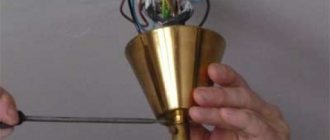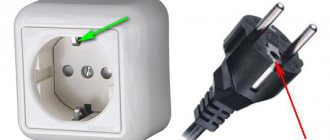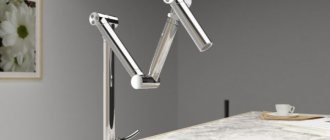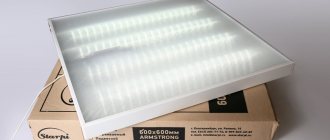Types of lamps used in suspended ceiling structures
Several types of lighting fixtures can be used in suspended ceiling systems:
- Halogen. This type of lamp produces diffused light, which is best perceived by the human eye. A halogen lamp can be installed with the smallest gap, and the service life of the device depends on whether the installation is carried out correctly. If you buy low-voltage elements, then they are suitable for use in rooms with high humidity. However, this version of the lighting device does not tolerate sudden voltage surges, which is why it can fail much faster. This issue can be solved with the help of a voltage stabilizer, which experts recommend installing. Replacing a failed halogen lamp, especially if it is built-in, is much more difficult than a regular one. By carrying out the work in stages, every home craftsman can cope with this task.
- Anyone can replace standard incandescent lamps. After all, everyone without exception had to do this kind of work.
- LED lighting sources. By installing a high-quality LED lamp, for example, “Ekola”, in a spotlight, you can create very beautiful panoramic lighting, and this option is the most durable and economical.
- Energy saving option. Such models consume the least amount of electricity. However, experts do not recommend using energy-saving lamps in rooms with high humidity. For example, in saunas or baths. The service life of such models directly depends on the number of on and off cycles, that is, the more often the lamp is turned on and off, the shorter its service life will be.
Knowing what type of lighting fixture is used in a suspended structure, it is much easier to independently replace a lamp that has become unusable.
How to change a light bulb in a suspended ceiling
Ceiling panels are often emphasized with the help of lighting placed in a certain way, and it is enough for one lamp to burn out for the appearance of the room to change, so it is better not to delay replacing them. But if in a regular chandelier it’s quite easy to change the lamp, then with a stretch ceiling it’s more complicated. Quite often, in order to pull it out, you need to remove the entire lamp from the socket. The algorithm of actions in this case depends on the type of lamps, namely:
- If there are ordinary incandescent lamps, then replacement will be simple - turn off the power supply in the room, unscrew the damaged element and screw in the working one.
- Replacing halogen or LED lamps is a more complicated matter. Start by turning off the power to the room, then remove the housing cover and retaining ring. If you need to replace a halogen lamp, do not handle it with bare hands; use a cloth or gloves. Often, in order to remove it, you need to shake it a little, only with gentle movements. If there is no effect, then try to carefully rotate it around its axis.
Important! There are lamps with LEDs, which are a single mechanism. In this case, the entire device changes!
How to change light bulbs in a suspended ceiling
As practice shows, in order to emphasize the beauty of PVC canvas, spotlights are used, which are placed in a certain order. Replacing a light bulb in a regular chandelier is quite simple, while with PVC sheets things are much more complicated. To remove the light bulb, you have to remove the entire device. The step-by-step algorithm of actions completely depends on the type of lamp used.
It is important to take into account the fact that you can often find lighting devices with LEDs on sale that are one piece. In such cases, the entire device must be replaced
Attention! If there is a need to change a spotlight on a suspended ceiling or replace a light bulb, it is better to do this as soon as possible.
How to change an LED lamp in a suspended ceiling
Today, LED lamps are especially popular. This demand is due to efficiency and fairly bright lighting.
To remove a lamp from a suspended ceiling, you should adhere to the following rules:
- check the serviceability of the lamp using a tester and turn off the electrical power in the entire room;
- take care of the presence of autonomous lighting if the room is dark for installation;
- remove the fastenings and remove the insulation from the electrical wires;
- replace it according to the instructions supplied with the new lamp;
- connect all wires, ensuring reliable insulation;
- install the lamp cover.
Despite the fact that LED lamps also have to be changed periodically, they are still more economical than other types.
How to change a halogen lamp in a suspended ceiling
As practice shows, halogen lamps installed in lighting structures on PVC fabric are much more difficult to replace than other types. Despite the presence of some difficulties that may be encountered during work, halogen lamps have some advantages, among which the following points can be highlighted:
- such light sources emit a rather soft and pleasant luminous flux, which is perceived quite well by humans;
- The service life is about 5 years, and if we compare the indicator with conventional lamps, then this period is impressive.
Before unscrewing the light bulb in the suspended ceiling, you will need to turn off the electricity. Once you have gained access to the halogen lamp, you will need to remove the fasteners and carefully remove the lamp from the socket.
How to unscrew a stuck light bulb from a stretch ceiling
Often you may encounter a problem when you need to remove a stuck light bulb from a stretch ceiling. Such problems occur very often. In such situations, some effort is required to remove the flask. If this doesn't help, you can try using pliers.
How to change a light bulb in a suspended ceiling: video
As practice shows, to carry out work on replacing lamps in a lamp, you need to adhere to a certain step-by-step work algorithm. If it is not possible to replace a light bulb in a suspended ceiling in this way, you can watch a video on this topic and clearly see all the stages of installation and dismantling of lighting fixtures on PVC canvas.
How to change light bulbs in a suspended ceiling
Plasterboard structures are more rigid, but it is better to avoid frequent manipulations with lighting fixtures, since the plaster in the area of the hole crumbles over time. The basic principles for dismantling and installing spotlights on plasterboard ceilings are the same as on suspended ceilings. Differences in execution techniques concern only the design of the soffit and the light source.
LED
LED elements are gradually replacing lamps of previous generations due to their efficiency, but they have a significant drawback: cheap devices have a flicker coefficient of more than 15%, which is noticeable when shooting video. The eyes become very tired from such light, and vision deteriorates over time. In this regard, it is better not to save money when choosing models for lighting residential and work spaces. The design of LED light bulbs implies the presence of a driver in the housing, so the devices operate directly from a 220 V network, and the lighting circuit does not require additional stabilizers and rectifiers. When changing an LED light bulb, simply remove it in a manner specific to the type of specific base and install a new one in its place.
Halogen
With high energy consumption and a short resource of 5000-10,000 hours, this source has optimal characteristics for vision. The glow of halogen lamps lies in a comfortable range of 3000-4000 K. In addition, their flicker coefficient is most often less than 5%, but only if high-frequency transformers and voltage stabilizers are used. In some cases, halogen failure is associated with failure of the rectifier. Therefore, if after replacing the light bulb the lamp does not work, you need to check the functionality of the remaining elements of the lighting circuit.
Luminescent
Gas-discharge light sources are rarely used for spot lighting, since their compactness is associated with low power. The principle of their operation implies the presence of a ballast in the lighting circuit, which, as a rule, starts a group of several fluorescent light bulbs at once. There are samples with built-in electronic ballasts, but its dimensions increase the distance between the main and suspended ceilings.
Most often, these lamps have an E14 screw base, so replacing them is not difficult.
Replacing GU5.3 and MR16 products in a suspended ceiling
Lighting fixtures that are installed in suspended ceiling structures have two main parts:
- functional;
- decorative
Functionality includes frame and clamps.
The replacement work consists of 4 stages:
- Power cut
. First of all, you should de-energize the room where the replacement is to be done. For this purpose, turn off the automatic lighting circuit in this room. It is permissible to use a switch for the lamp, but you cannot be sure that it will break the zero and not the phase. The fact is that if the craftsmen made a mistake when arranging the lighting, then the phase wire will remain energized, even when the light is turned off. It is better not to put yourself at risk and carry out all power outages directly in the panel. - Removing a burnt out light bulb
. First, remove the main retaining ring, which acts as a retainer. To do this, you need to remove two antennae, after which the light bulb itself falls out of the housing, while it hangs on the contact socket. It is then removed from the contacts by turning the GU10 model counterclockwise or by pulling the MR16 towards you. - Installation of a new lamp
. Before replacing a light bulb in a suspended ceiling, it is necessary to compare the power and voltage indicators on the new product with those on the burned-out one. Lamps can have the same shape and different supply voltages. For example, instead of 220V it will be 12V. The main thing is that the power matches or does not exceed the previous value, otherwise the lamp will most likely overheat or, if there is a power supply, it will be overloaded. When all the data matches, plug connectors are inserted into the contact sockets of the lamp being installed on the socket. - Installing the lamp in its original place and fixing it
. Again use the retaining ring. His ears are squeezed, placed in the grooves and released. After the light bulb is secured, turn on the lighting.
There are models that do not have retaining rings. In this case, before changing the LED lamp in the suspended ceiling, you will need to completely remove the lamp from the ceiling structure.
The reasons for this may be the following:
- the springs deformed the housing of the lighting device;
- since the springs are of the wrong size, they begin to put excessive pressure on the body - this usually happens when several light bulbs are replaced at the same time, when the rings are mixed up and not installed in the same places;
- The ceiling structure is mounted at an insufficient distance from the ceiling and the lamp and socket rest against the plaster.
Subtleties of work
Changing a low beam lamp in a car with your own hands will not be difficult. You just need to take into account certain subtleties and recommendations of specialists, which will allow you to complete all the work quickly, efficiently and subsequently eliminate any difficulties with the functioning of lighting devices.
Replacement of the low beam lamp is carried out only with the battery disconnected. The battery can only be de-energized with the engine turned off. Otherwise, there is a risk of electric shock or a short circuit in the network, which can burn wiring and other important components with electronic units in the car.
You can often hear recommendations from experienced car owners to use ordinary wire instead of fuses. Indeed, on the road, if the insulators are burned out, in the absence of the latter, you can install metal clips in the mounting socket, which will temporarily solve the existing problems. However, you should not constantly operate the machine with such protective fuses. In this case, there is a high risk of short circuits, damage to the vehicle's control units and, in particular, to the expensive xenon module or the light bulbs themselves.
The car owner should regularly inspect the headlights to detect clouding of the glass and lens. Their darkening is a signal to change the low beam bulb, which will eliminate various kinds of troubles already on the road, when it is simply impossible to promptly purchase failed devices. The presence of condensation inside lighting equipment is a serious problem, which indicates a loss of sealing and the need for appropriate repairs. In rare cases, such headlights have to be replaced with new ones, which leads to significant expenses for the car owner.
It is necessary to choose the right type of light bulb, its power and type of base. This will ensure the quality of road lighting, the maximum possible durability of the lamp, and the absence of any problems when using it. If you are tuning a car and replacing lights, then such work should be performed exclusively by professionals using high-quality ignition units and original components.
How to change a light bulb in a spotlight on a suspended ceiling
Depending on the type of socket, light bulbs are removed differently. Let us consider in detail the replacement process for each type of base. Before starting work, it is better to turn off the power supply at the panel, otherwise there may be an electric shock.
G5.3
It is not very convenient to remove light bulbs of this type from spots, since the outer part is recessed into the lamp body and is located above the plane of the stretch ceiling. In the lampshades they are held in place using a special retaining ring or a wire clamp with antennae at the ends. Such lamps are compatible with LED and pin-type halogen elements.
To change a light bulb with a G5.3 socket, you need to squeeze the two antennae and pull out the fixing bracket. If a retaining ring is used as a retaining part, it is simply unscrewed. The lamp falls out. Then you need to disconnect it from the contacts by pulling it towards you. After this, a new lamp is connected, inserted into the lamp body and the fixing ring is installed in place.
Sometimes the retaining ring does not fit back in after replacing the light bulb. This happens for several reasons:
- the body is deformed - it will have to be replaced;
- the ceiling is fixed too high and the base rests on the concrete base - you need to purchase a lamp of exactly the same size, a difference of 1 mm can cause a problem;
- The fasteners are the wrong size - this happens if you had to unscrew several light bulbs and the rings were mixed up.
GX53
In luminaires with a GX53 base, the lamps protrude beyond the ceiling by 3-4 mm. On their back side there are two contact pins that are inserted into the corresponding grooves on the body of the lighting fixture. Dismantling is carried out by turning the lamp counterclockwise until it clicks, then it is simply pulled out.
Replacement is very easy; there is no need to install fixing parts or disconnect wires. Simply insert the new lamp and turn it clockwise.
G4, G9
The design feature of such lamps is that the body protrudes beyond the plane of the ceiling. LED and halogen pin-type models are available with G4 and G9 sockets. To dismantle the lamp, just pull it down. Then simply insert the new one into the groove. There is no need to rotate the lamp. In some models, you first need to disassemble the spotlight, namely, unscrew the decorative diffuser.
E14, E27
Such lamps are changed in the same way as in a regular chandelier or sconce.
Holding the flask, carefully unscrew it counterclockwise. Then screw the new one in until it stops, but without effort.
Sometimes the light bulb is difficult to grasp with your fingers, in this case you can use masking tape.
How to change a light bulb in spotlights
For studio and designer lighting, spotlights are used that are attached to the surface of the ceiling or walls directly through the canvas to the platform or by means of a mounting rod.
Fastening to the guide rail.
The peculiarity of the spots is the ability to adjust the direction of the light spot by turning the lamp body on a hinge. The light bulbs in such devices are held by fastening in the socket, and for their removal there is a special vacuum applicator, which is a suction cup.
Dismantling with a vacuum applicator.
The replacement process is quite simple:
- The circuit is de-energized.
- A suction cup is pressed against the plane of the light bulb.
- Depending on the type of base, the applicator pulls toward itself (for GU5.3) or turns counterclockwise 15-20 degrees and extends (for G10).
- The new light source is installed in the reverse order. If the base is pin, type GU5.3 or G9, then the light bulb is simply inserted until it locks. If the base is screw-type, it must be screwed in until it stops (for E14) or clicks, like in G10 or GX53.
If the applicator is not available, you can get the lamp by covering it with tape, as in the photo.
Step by step removal using masking tape.
Types of lamps and recommended lamp power
According to the installation method, spotlights are divided into two types:
- Built-in. The main part of the device is hidden behind the canvas. The bottom edge is at the same height as the ceiling and does not protrude beyond it. Because of this, the overall level of the structure drops slightly. With this arrangement, the spots are less noticeable, but the flow of light is more narrowly focused. The lamp and the canvas around it heats up more and takes longer to cool down.
- Invoices. The lamp is fixed at ceiling level, and the body is located below. When placed outdoors, the device is more noticeable, but it cools faster and illuminates the space more evenly. This type is safer to use.
The body is made from different materials: glass, crystal, aluminum, plaster, plastic. The shape can be round, square or rectangular. To choose the appearance, take into account the overall style of the room. It is advisable to purchase lamps designed specifically for suspended ceilings. They are designed in such a way that the rays do not shine through the canvas around them. Drywall is a denser material, so suspended ceilings do not have such problems.
There are several types of light bulbs:
- Incandescent lamps. They are almost never used with suspended ceilings, as they get very hot.
- Halogen. A relatively expensive option and they also generate a lot of heat.
- Energy saving. They are convenient where constant lighting is required, and when turned on frequently they consume a lot of electricity.
- LED. Economical and durable, practically do not heat up.
The most common types of base:
- G5.3 (for halogen and LED lamps);
- GX53 (led and energy saving);
- G9 (halogen and LED for surface-mounted luminaires).
Previously, only light bulbs operating on 12V voltage were produced. A transformer was required to connect to the power supply. Now there are lamps on sale that operate directly from 220V.
Types and features
Before replacing a light bulb, you need to find out its type and purchase a new one. When choosing a lamp, you will need to take into account several characteristics.
Base
An important element of any light bulb is the base. The purpose of the element is to connect the conductive parts of the lamp and the corresponding socket. Lamps may have the same glass bulb, but differ in the type of base.
The marking of the base is determined on the basis of an internationally accepted standard, which allows you to purchase the desired option, knowing the combination of letters and numbers. The first letters in the marking indicate the shape of the base, and the numbers indicate the distance between the contacts, thread diameter or external dimensions of the base body.
Threaded
Threaded sockets are often used in incandescent lamps and energy-saving lighting sources. This variety is known to many as the Edison base
When choosing lamps with a threaded base, you need to pay attention to the numbers in the marking, which in this case determine the outer diameter of the thread
Pin
A type of pin base is designated by the Latin letter G. A pin system is used to connect the light bulb to the socket. The numbers in the name indicate the gap between the central parts of the pins, and if there are a large number of pins, the diameter of the circle on which their centers are located.
Bayonet
This type of base has a modified design of the threaded element. The function of the thread is performed by pins located on the sides, on which the light bulb is fixed in the socket. Depending on the manufacturer, the bayonet base is marked with the Latin letter B or Russian Ш. The number of contacts is indicated before the letter, and the diameter of the case after the letter. Thanks to precise fixation, bulbs with a bayonet base can be two- or three-pin.
Lamp type
In addition to the type of base, when replacing a light bulb in a suspended ceiling, you need to know its type. There are several types of lamps that have distinctive characteristics and features.
Incandescent
Incandescent lamps are the most common option and are light sources that emit a stream of light due to the incandescence of a tungsten conductor. The refractory metal has a high melting point, which is why it is used in lighting devices. The filament is placed in a glass bulb filled with an inert gas to protect against oxidation. Low power incandescent lamps are produced without the use of inert gas. The advantages of this type include:
- affordable price;
- instant on;
- large power range.
In comparison with other varieties, several negative aspects can also be identified. For example, a short service life and low efficiency, since only a tenth of the electricity consumed is transformed into light radiation.
Halogen
Halogen lamps are similar in design to standard incandescent lamps. Inside a large flask made of transparent or frosted glass there is a thin tungsten filament surrounded by a gas mixture. As a result of applying current, the thread heats up to 2500 degrees. When heated, the tungsten filament glows white, but the illumination depends on the color of the bulb.
Luminescent
Fluorescent lamps are made in the form of an oblong glass tube, sealed on both sides. The inside of the tube is coated with phosphor, and the space is filled with inert gas. The lamp also contains small amounts of mercury, which heats up and creates mercury vapor. The glow of fluorescent lamps is based on the heating of a tungsten element and subsequent radiation, which is absorbed by a special composition, which produces a bright light.
High power of fluorescent lighting sources is possible thanks to the internal phosphor coating. With the same electricity consumption, the power is higher than that of incandescent lamps, so the fluorescent type is also considered energy-saving.
LED
The main feature of the LED lamp variety is reduced energy consumption. Another advantage is the long service life, which can reach 100 thousand hours. LED products can work with any voltage and there is no need to additionally install ballast resistors.
Halogen lamps
Such lamps have recently become increasingly popular. Of course, they have plenty of advantages, but practically no disadvantages. They provide natural diffused light that is easily perceived by the human eye. Of course, one halogen light bulb will not be able to provide the necessary lighting, but when united in a group, they create a complete light source. The average lifespan of such lamps is 3-4 years, and if it fails at the end of the specified period, replacing it will not be difficult.
So, how to replace a halogen light bulb:
- Turn off the electricity;
- Pull out the fastener that secures the light bulb;
- carefully disconnect the bulb that has failed from the socket;
- take a new lamp and attach it in place of the one you pulled out;
- Place the lamp in its original place and secure it using a special fastener.
Now you know how to change a light bulb in a suspended ceiling, but before you buy a new replacement, we advise you to unscrew the old lamp and take it with you to the store. This way you won’t go wrong when choosing the right model.
Since all types of lamps are identical in their structure, the technology for replacing them is not particularly different. But we still offer you to watch a video about replacing a light bulb in a spotlight.
Previous articles from the category:
Options for placing spotlights on the ceiling
Even installing the most fashionable chandelier model will not give you the ideal lighting effect; in any case, it will attract the attention of others to the maximum, and some areas of the room will not be sufficiently illuminated. All this can be easily avoided if you make the correct placement of spotlights on the ceiling
Lighting for suspended ceilings - photo gallery
The idea of suspended ceilings goes back to ancient times, when ancient craftsmen decorated the ceilings of nobles and kings with silk fabric. The stretch ceiling looked luxurious and captivated the eye. Today, when lighting for suspended ceilings was invented, the most daring ideas have no boundaries - these are twinkling stars and the fiery sea of sunset...
Installing a chandelier on a suspended ceiling
You decided to renovate, which in our time is already a small feat, but as a final touch, you wanted to install a stretch ceiling and suddenly the question arose of how to hang a chandelier on a stretch ceiling? But I just want a chandelier...
Types of socles
Regardless of what type of lighting device is used to illuminate the room: energy-saving, halogen, LED, incandescent, you need to decide on the type of mounting. When choosing, the design of the lamp is taken into account. In order to figure out how to change a light bulb in spotlights, you need to learn about the types of bases.
What is a base? This is the part of the light bulb that is used to mount the structure in the socket. In addition, it serves to conduct electricity. Without a base, the lamp will not work. Despite this, baseless devices are sometimes used. They are designed to conduct light in automotive applications.
The design of the base is simple: the body is made of metal or ceramics. Inside are the elements of the light bulb, outside are the contacts for connection.
Each type is marked with letters and numbers. The letter means type, the number means characteristic.
Screw
The most common type for apartments is a screw base. Marked with the letter "E". This is the oldest type of light source mounting. Invented by Edison. The original name is “Edison Screw Type”, or Edison screw type. Hence the letter "E". The number indicates the outer diameter.
Among all Edison sockets, the most common is E27. Lighting fixtures with a diameter of 27 are the most popular in Russian apartments because it is easy to find a light bulb for them. E27 is equipped with traditional incandescent lamps, but has recently been found in halogen, fluorescent and LED lamps.
E14 is also found on the market. They call him "minion". This type is most often found in sconces, table lamps, but sometimes also in suspended and suspended ceilings. Less commonly used are “E” with diameters of 5, 10, 12, 26, and so on.
The main advantages are the prevalence and ease of fastening. There are no shortcomings observed.
Shtyrevoy
This type of base does not use a screw, but a pin connection system. The numbers indicate the distance between the centers of the pins. Used in halogen and energy-saving lamps. Denoted by the letter "G".
The G4 connection is used in small halogen light bulbs. Most often used for decoration, in spotlights, as well as in built-in lamps. There is a G9 type. Used in 220 V AC power supply, suitable for decorative lamps.
For office lighting use tubular G5. For compact lighting fixtures, there are sockets with four pins (2G10, 2G11). There are many such lamps. In order not to get confused when buying a new light bulb, it is recommended to take with you an old, burnt-out light source.
In addition to the types described above, there is the “GU” type. This means that the lamp is energy saving. The most common for suspended ceilings is GU5.3. Their thickness is 2.7 centimeters.
Bayonet
This type of connection is also called bayonet or pin. The source is installed in the lighting fixture by inserting and scrolling. Widely used for various purposes, most often in suspended, stretch ceilings and cars. The device operates in the presence of strong vibration.
This type of connection between a lighting fixture and a light source is often used in transport and more. For example, in the UK this is a standard connector.
Bayonet fasteners are usually designated by the letter “B”, and the number that comes after the letter indicates the outer diameter of the connector.
There are bases with different numbers of contacts (from 1 to 5). They are also designated by the letter:
- “s” - single contact;
- "d" - double;
- “t” - three contacts;
- "q" - four;
- "p" - five.
In everyday life, as a rule, lamps with one and two contacts are used. The rest are in production.
How to unscrew a lamp from a suspended ceiling?
If a lighting fixture in the suspended ceiling has burned out or started to glow dimly, it needs to be replaced. Some people don’t know how to remove a light bulb, so they resort to the help of a professional. You can do the work yourself. The process is simple, the main thing is to know some subtleties. This article describes in detail the types of light bulbs, as well as how to change a light bulb in a suspended ceiling.
Types of light bulbs
There are 4 main types of light bulbs for pendant type coverings:
- incandescent lamps;
- halogen;
- luminescent;
- LED
There are actually other types, but these 4 are used in 99% of cases. They differ from each other in operating principle, design and other characteristics. For example, the consumption of electrical energy differs significantly.
Heating is an important indicator. The hotter the lighting fixture gets, the less energy is available for lighting. They also differ in such indicators as strength, service life, ease of installation and even environmental friendliness of the product.
The environmental friendliness of a lamp, oddly enough, is an important indicator. For example, some devices emit spectrum harmful to humans. Flickering, in turn, causes strain on vision. Some lamps contain mercury vapor. When destroyed, mercury is harmful to health.
Incandescent lamps
Currently in Russia this is the most common type of light bulb. It comes in different sizes, shapes and with different energy consumption. A classic incandescent lamp is an electrical device that emits light. Roughly speaking, the design consists of a metal base, a sealed glass bulb and a twisted tungsten filament.
Operating principle: as electricity flows through the thread, it heats it up. Due to heating, the filament heats up and begins to glow. Incandescent light bulbs are thought to be inefficient because most of the energy goes into heating rather than lighting. Consequently, the device heats more than it illuminates.
Today, this type of lighting fixtures is outdated; manufacturers are switching to newer types. It would seem that they are cheaper than, for example, LED ones, why are they produced and used less? The fact is that other types consume less electricity. This makes them more economical. Their service life is also inferior to other products.
Halogen
This type is designed for an incandescent lamp. This is an ordinary lamp, but inside it there is a gas consisting of bromine, iodine and halogen. Hence the name. In the process of creating such a device, more modern technologies are used. Halogen Features:
- good color rendition;
- bright light;
- directional beam, illuminates more efficiently.
Although such products shine brighter and have a longer service life, they are not energy saving because they consume about 45 W. They get very hot, the structure is fragile, and is destroyed if dropped.
Among the advantages, I would like to highlight the preservation of lighting quality. It also does not change the color of objects, such as incandescent type. Service life is about 2 thousand hours, or more than 80 days of continuous operation. Well suited for a spotlight. As you know, changing a halogen light bulb in a suspended ceiling is easy. This is another advantage.
The only significant drawback is the strong heating. To avoid damaging the lighting fixture, it is recommended to use heat-resistant materials.
Luminescent
Often called energy saving. These are more modern lighting fixtures. Low energy consumption: 15 W. Thanks to the ease of installation, there will be no such difficulty as removing a fluorescent light bulb from a suspended ceiling. In Russia, they began to be used at home about 9-10 years ago. Previously used in offices and factories.
They are a container with mercury vapor, which creates ultraviolet radiation during electric current. The rays are converted into light using a phosphor.
- low energy consumption;
- long service life;
- medium heat;
- variety of shades of light (cold, daytime, warm);
- do not flicker, thereby not loading the eyes;
- ease of installation/replacement.
Disadvantages of energy-saving lamps:
- high cost (several times more expensive than an incandescent lamp);
- wear depends on the number of inclusions;
- contraindicated for skin diseases, epilepsy;
- contains mercury vapor, which, when broken and inhaled, is harmful to human health;
- cannot be thrown away; faulty devices should be handed over to a collection point.
LED
It is considered the most modern and economical option. When compared with other lighting devices, LEDs have the best characteristics. The design uses LEDs. The principle of operation is a separate topic. It is more complex, hence their cost. The price pays off quickly. The source is also environmentally friendly, the materials do not harm the environment.
Among the advantages, I would like to highlight the long service life (more than 30 thousand hours). The light source consumes approximately 10 W, but does not heat up. The design is durable and easy to install. LEDs are resistant to vibration and shock. They work in different climatic conditions, at a wide range of temperatures. Withstands any stress.
The only drawback is the high price. But thanks to low consumption and long service life, it quickly pays for itself. It is also not always possible to install this type of lighting fixture. It is considered the best light source for suspended and suspended ceilings.
Before changing or installing an LED lamp in a suspended ceiling, it is recommended to familiarize yourself with the existing bases.
Types of socles
Regardless of what type of lighting device is used to illuminate the room: energy-saving, halogen, LED, incandescent, you need to decide on the type of mounting. When choosing, the design of the lamp is taken into account. In order to figure out how to change a light bulb in spotlights, you need to learn about the types of bases.
What is a base? This is the part of the light bulb that is used to mount the structure in the socket. In addition, it serves to conduct electricity. Without a base, the lamp will not work. Despite this, baseless devices are sometimes used. They are designed to conduct light in automotive applications.
The design of the base is simple: the body is made of metal or ceramics. Inside are the elements of the light bulb, outside are the contacts for connection.
Each type is marked with letters and numbers. The letter means type, the number means characteristic.
Screw
The most common type for apartments is a screw base. Marked with the letter "E". This is the oldest type of light source mounting. Invented by Edison. The original name is “Edison Screw Type”, or Edison screw type. Hence the letter "E". The number indicates the outer diameter.
Among all Edison sockets, the most common is E27. Lighting fixtures with a diameter of 27 are the most popular in Russian apartments because it is easy to find a light bulb for them. E27 is equipped with traditional incandescent lamps, but has recently been found in halogen, fluorescent and LED lamps.
E14 is also found on the market. They call him "minion". This type is most often found in sconces, table lamps, but sometimes also in suspended and suspended ceilings. Less commonly used are “E” with diameters of 5, 10, 12, 26, and so on.
The main advantages are the prevalence and ease of fastening. There are no shortcomings observed.
Shtyrevoy
This type of base does not use a screw, but a pin connection system. The numbers indicate the distance between the centers of the pins. Used in halogen and energy-saving lamps. Denoted by the letter "G".
Bayonet
This type of connection is also called bayonet or pin. The source is installed in the lighting fixture by inserting and scrolling. Widely used for various purposes, most often in suspended, stretch ceilings and cars. The device operates in the presence of strong vibration.
This type of connection between a lighting fixture and a light source is often used in transport and more. For example, in the UK this is a standard connector.
Bayonet fasteners are usually designated by the letter “B”, and the number that comes after the letter indicates the outer diameter of the connector.
There are bases with different numbers of contacts (from 1 to 5). They are also designated by the letter:
- “s” - single contact;
- "d" - double;
- “t” - three contacts;
- "q" - four;
- "p" - five.
In everyday life, as a rule, lamps with one and two contacts are used. The rest are in production.
How to change a light bulb in a suspended ceiling spot
When working with electricity, follow safety precautions to avoid electric shock and personal injury.
1. The electricity goes out. After this you need to wait a minute or two.
2. Now you need to find a support: stepladder, stool, bedside table. You must stand firmly so as not to fall while working.
Advice! When performing any type of work with suspended or suspended ceilings, you must be very careful. In the case of stretched fabric, it can be easily damaged if moved carelessly. You should also be careful with hanging systems so as not to damage anything.
3. Now the lamp replacement itself:
- In the case of a classic incandescent light bulb, you need to grab the bulb firmly (not so much as to crush it), turn it counterclockwise and unscrew it.
- If it is a bayonet socket, then you need to turn and pull out the light bulb.
When removing, you need to unlock the light bulb in the holder itself by unscrewing the ring. Be careful, the ring is springy.
What errors occur
The most common mistake is failure to comply with safety precautions (more on this later in the article). In addition, people often make mistakes in choosing the appropriate lamp. When purchasing, you need to pay attention to the markings and type of base.
Often, during installation, the light bulb does not screw in completely. Because of this, after turning on, the device does not light. When installing, you need to hold the lamp firmly and make sure that it is screwed in completely. This is especially true for screw and pin type cartridges.
Safety precautions
The most important rule is to be careful. Ignorant people should not work with electricity. First of all, you need to turn off the power in the branch, preferably in the whole house. After disconnecting, wait a little time.
It happens that when replacing a light bulb falls and breaks. In this case, you need to be careful not to cut yourself.
Also, you should not handle a halogen or incandescent lamp with your hands immediately after turning it off, because they get very hot and there is a chance of getting burned.
Another point is to pay attention to the rated voltage of the lamp.
You can replace a light bulb in a suspended or suspended ceiling yourself. The main thing is to understand what light sources exist, as well as existing cartridges. It is also important to remember safety precautions. It is important to remember that electricity is dangerous.
Recommendations for replacing lamps
When replacing lamps on a suspended ceiling, always adhere to the following rules:
- always turn off the power supply to the lighting fixture;
- you need to make sure the integrity of the wiring and the reliability of the contacts;
- always consider what voltage they are designed for;
- in case of mechanical damage to a fluorescent lamp, it is necessary to carefully clean the remaining traces when broken from the walls and ceiling, because they contain mercury vapor;
- if the halogen lamp cannot be pulled out, then it is better to remove the entire lamp, after which it can be easily removed;
- It is necessary to familiarize yourself in advance with the technical data and features of using certain types of light sources for a suspended ceiling.
For information on how to replace a light bulb in a spotlight, see below.
Type of lamps used in suspended ceilings
There are mainly four types of light bulbs used in suspended ceilings.
Halogen. This type can be installed with the least amount of space between the false ceiling and the main one. Halogen bulbs can light up a room quite brightly and are a little more difficult to replace than a regular light bulb.
Care must be taken when replacing. The service life of this type of lamp largely depends on proper installation
In the household network there are frequent voltage drops, which do not have a positive effect on the operation of the light source. For this, it is recommended to use voltage stabilizing devices.
Regular incandescent lamps. Each of us has known these products since childhood, and changing them does not require much difficulty or knowledge. But ordinary lamps have one significant drawback: they heat up quickly and therefore are not suitable for all types of suspended ceilings.
- Fluorescent lamps. This type of lighting, even despite its high cost, has become widespread. They are very economical and consume the least amount of electricity, and their lighting characteristics are much higher than previous models. They have a number of negative qualities - products with a hot start light up slower than other analogues, have a limit on the number of switches on and off, and they contain mercury vapor, which further complicates the disposal process.
- LED bulbs. A more economical and long-lasting option for this type of ceiling. Their brightness sometimes exceeds the similar characteristics of luminescent products. The operating period of LED lamps reaches 72,000 hours of production, while a conventional lamp has only 1,000 hours.
When changing different lamps, it is necessary to take into account that they use two types of base. The first is with a regular right-hand thread and is used for a classic cartridge. Most of us know how to change a light bulb with this type. The second option is a G-shaped base with different types, the lamps are installed using the two pins provided. These pins perform a guiding function, and strong fastening occurs after a characteristic click.
Suspended ceiling as a light source
Before installing the suspended ceiling, a frame is assembled from wooden blocks or metal profiles, which are directly mounted to the concrete or wooden ceiling of the room. Then the ceiling covering itself is attached to the frame. The ceiling material for such a ceiling can be, for example, plasterboard. But such ceilings can also be suspended, in which the ceiling covering is made of strong synthetic material. These designs perfectly hide all defects in the main ceiling of the room and give it an even and smooth look.
Between these two ceilings (main and suspended), thanks to the assembled and fixed frame, a free space of up to 10 cm is formed. Electrical wiring for connecting future lighting and the main structural elements of the light source are hidden in this empty space. To connect lamps and various light sources, special holes are made in such a ceiling. A distinctive feature of this ceiling is the possibility of installing built-in lamps.
Reasons for replacing light sources
Replacement of lighting devices can be planned or unscheduled. Planned replacements are prepared in advance and are related to the owners’ desire to change the interior of the room. During such work, recessed spotlights (their appearance and design), pendant single light sources, chandeliers and overhead lamps may change.
Unscheduled work is related to the need:
- replace a burnt out light bulb;
- dismantle all light sources due to the need to remove the canvas - this occurs mainly due to flooding by neighbors above;
- wipe the lampshade from dust.
The ceiling panel must be dismantled.
LED option
How to change an LED lamp in a suspended ceiling? It is believed that it is most profitable to install LED ones, since they consume little electricity. They also have a long service life. Such lamps are convenient and profitable because they do not require large expenses.
When the “tablet” burns out, people ask how to change the LED light bulb in a suspended ceiling. This process will not take much time and effort, you just need to follow a certain algorithm of actions:
- You need to turn off the electricity in the apartment.
- Don't forget about an additional light source, especially in the evening. A flashlight will come in handy when replacing a lamp.
- First of all, the mounts from the previous lamp are removed.
- It is necessary to remove the insulation from the wiring.
- Carefully disconnect the required wires.
- You must first study the instructions that come with the new lamp.
- A new LED lamp is installed in place of the old one.
- You should connect the necessary wires and secure the new light source. For this, special screws are used.
According to stores, most people purchase LED lamps for installation in suspended ceilings. The demand for them is constantly growing.
Types of light bulbs
- Incandescent light bulb - has the highest luminous power, is not very durable and heats up noticeably. However, its size, shape and power vary over a very wide range, so changing it is not difficult. In addition, it tolerates voltage fluctuations well and is not too sensitive to moisture: it can be used in the bathroom either in a regular chandelier or in an Armstrong suspended ceiling module.
- Metal halide - has excellent light output and much better color rendering, can generate excellent daylight, and does not affect the shades at all. The durability of the device is higher, but the sensitivity to voltage drops, especially in the acoustic range, is high.
Before changing such a light bulb, you need to accurately determine its type. Devices are produced for a variety of purposes, including operation in a specific position.
Can be installed without restrictions in any type of lamp, including on a suspended ceiling. This is the most economical type of lighting, but is also sensitive to voltage changes and moisture: they are not used in the bathroom. In the photo there is a spotlight.
LED lamps have all the above advantages and are free from all the disadvantages: they are slightly inferior in light output to fluorescent lamps, withstand weather conditions well, are extremely durable, do not heat up and are completely safe. Can be used both in the bathroom and outdoors. There is only one thing - the cost.
Replacing an LED fixture is as easy as replacing a regular one.
Stages of replacing the light source
First, you should remove the lamp by removing the retaining ring that secures it to the ceiling. To do this, you need to carefully pick up the tendril, remove the ring and put it aside, as it will be needed for reinstallation. Then, depending on the type, you should carefully pull out or unscrew the light bulb from the socket, holding it with your free hand. Regular and halogen light bulbs simply unscrew. If it collapses, you should collect the fragments, and then unscrew the base using pliers, making sure that the cartridge is not damaged. In this case, it is also necessary to choose the correct size of the base.
Before installation, it is necessary to correctly determine the power and operating voltage of the lamp in order to ensure the desired level of illumination. You need to check the data on both lighting devices and their packaging, since, for example, there are LED lamps with a GU 5−3 base, designed for 12 and 220 volts. The power of the new source should be the same or slightly less than that of the old one. Otherwise, the lamp may overheat, and the power supply provided by its design may burn out. Do not handle the bulb of halogen lamps with dirty hands - this will significantly shorten their service life.
After a successful check, you can insert or screw the lamp into the socket. Then you should install the spotlight in its place. After this, you need to take the locking ring, squeeze its ears, insert the ends into the grooves and release. After making sure that the lamp is securely fixed, you can supply electricity to the house and turn on the lights.
Components of the structure
Almost all lamps have a similar design, including:
- housing holding wires and cartridge;
- clamps to ensure reliable fixation of the lamp body;
- protective cover made of glass or plastic;
- a clamp with which the entire installation of the structure is fixed to the ceiling.
If you know about the structure of all elements, replacing a burnt out light bulb will be much easier.











